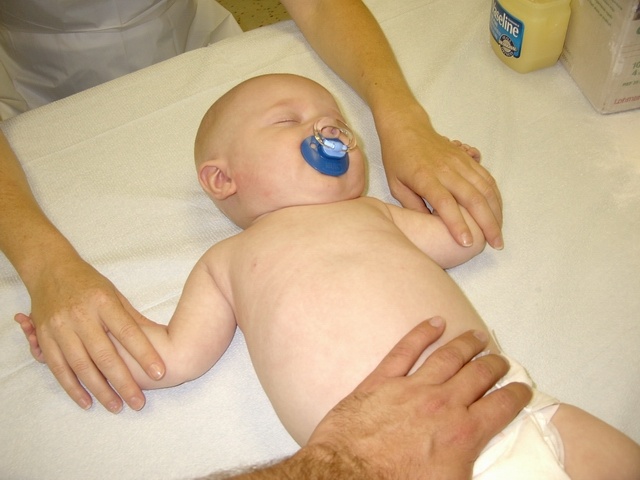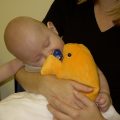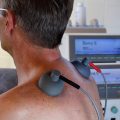Table of Contents
Congenital torticollis is the most common type of torticollis that’s present at childbirth. Unfortunately, the causes of cortical congenital torticollis are still unknown. Intrauterine malposition or birth trauma is considered as a cause of damaging the sternocleidomastoid muscle in the neck. There are other changes in the muscle tissue that arises from the recurrent trauma experienced by the child in the uterus or a sudden change in calcium concentration can cause prolonged periods of muscle contractions in the baby’s body, also medically known as congenital torticollis.
One of these mechanisms can produced excessive or shortened contraction of the sternocleidomastoid muscle which can then limit the range of motion in terms of lateral flexure and rotation. The head often tilts toward the lateral side and bend towards the affected muscle, and it can also be rotated toward the opposite side. To make it short, the head can turn the direction toward the shortened muscles with the chin tilted in the opposite direction.
Congenital torticollis is usually present when the child reaches 1 to 4 weeks of age wherein a hard mass can begin to develop. This is a disorder diagnosed using color histogram or ultrasound, and also through a clinical evaluation of the passive range of cervical motion of the baby.
Sinusital torticollis is also one of major cases seen in clinical practice. The reported incidence of congenital torticollis is around 0.3 to 2%. Sometimes the sternocleidomastoid tumor can be seen when the child reach around two to four weeks old and even if it eventually disappear when the child reaches around eight months, the muscles will be left in a fibrotic state.
Physical Therapy for Congenital Torticollis
Physical therapy is one of the best options to treat congenital torticollis in a cost-effective and non – invasive way. While outpatient physiotherapy is effective, parents can choose a home therapy performed by the baby’s mom or dad. This method is equally effective in reversing the effects of congenital torticollis. Lateral neck flexion and the overall range of motion can return quickly in babies if their parents assist in doing physical therapy exercises a couple of times a day.
The physical therapist should teach parents to do the following exercises:
- Stretch the baby’s muscles in the prone position both actively and passively
- Stretch the baby’s muscles in the lateral position supported by the pillow. The baby lying on his side with the neck supported by the pillow. The affected side should fight the pillow to stray the neck towards the unaffected side.
- The baby’s posture should be controlled in strollers, car seats and swings. You can use U-shaped neck pillows or blankets to hold the neck in a neutral position.
- Exercise active rotation in the supine, sitting or stomach position. You can use toys, lights and sounds to draw the baby’s attention to rotate the neck and look toward the unaffected side.
- Passive cervical rotation like stretching when supported by pillow has affected bottom side before positioning the baby in a cradle with each side hit by wall so that they have time to switch and let the unexposed side to face out.
Physical therapists usually encourage caregivers as well as parents of babies with congenital torticollis to change the environment in a way that will improve the movement or position of the baby’s neck. This may include the following:
- Add a neck brace to the car seat to achieve optimal neck alignment
- Reduce time spent in one position
- Use toys to encourage children to look toward restricted neck motions
Microtherapy for Congenital Torticollis
According to a recent Korean study, there’s an additional treatment that can help babies with congenital torticollis. These are micro therapies which could prove as an effective treatment. For this therapy to be effective, babies who are less than three months old, especially those who have congenital torticollis, where the sternocleidomastoid muscles with a palpable mass and a thickness of muscle above 10 mm. Microwave therapy involves sending electrical signals per minute to the network in order to restore the normal frequency in the cells. Micro – therapy is completely painless even for babies and children may only feel a slight probing by the machine on their skin.
Micro – therapies are thought to increase protein synthesis and ATP, improve blood flow, and reduce muscles as well as inflammation and pain. These treatments should be used in addition to the regular stretching exercises as well as diathermy ultrasonography. Ultrasound diathermy produces deep heat inside the body tissues to help contractures, muscle aches and pains and reduce inflammation.
The combination of these treatments showed remarkable results when it was tested among children who were maintained in the rehab program: Micocurrent therapy can cut the length of the rehabilitation program by nearly half with full recovery seen after 2 to 6 months. About 5-10% of cases fail to respond to stretching and require surgery of the muscles.
Surgery for Congenital Torticollis
The release of surgery involves the two sternocleidomastoid muscle in the head. This can be done laparoscopically and in a minimally invasive way. Usually, surgery is performed on babies under 12 months. Surgery is for babies who don’t respond to botulinum toxin injection or to physical therapy, or those who have a very fibrotic sternocleidomastoid muscle. After the surgery, the baby will need to wear a soft neck collar. He/ she will also need to go through an intensive physiotherapy program for 3 to 4 months and do strengthening exercises for the neck muscles. Other treatments include the following:
- Rest and analgesics for acute cases
- Diazepam or other muscle relaxants
- Botulinum toxin
- Encourage active movement for children 6-8 months
- Ultrasound diathermy
Breast Feeding for Babies with Congenital Torticollis
If the baby is a sleepy feeder or he/ she falls asleep while eating frequently, the effort of feeding may be overly fatiguing. This is another good reason to use an easy position when a baby is newborn and trying to regain his weight, and also for anytime, that baby might be especially tiring. The baby may need to take a break between sides or may need a bottle if still hungry following 15 – 20 minutes at one breast. These are some of the things you can do if your baby has congenital torticollis.






 I love to write medical education books. My books are written for everyone in an easy to read and understandable style.
I love to write medical education books. My books are written for everyone in an easy to read and understandable style.